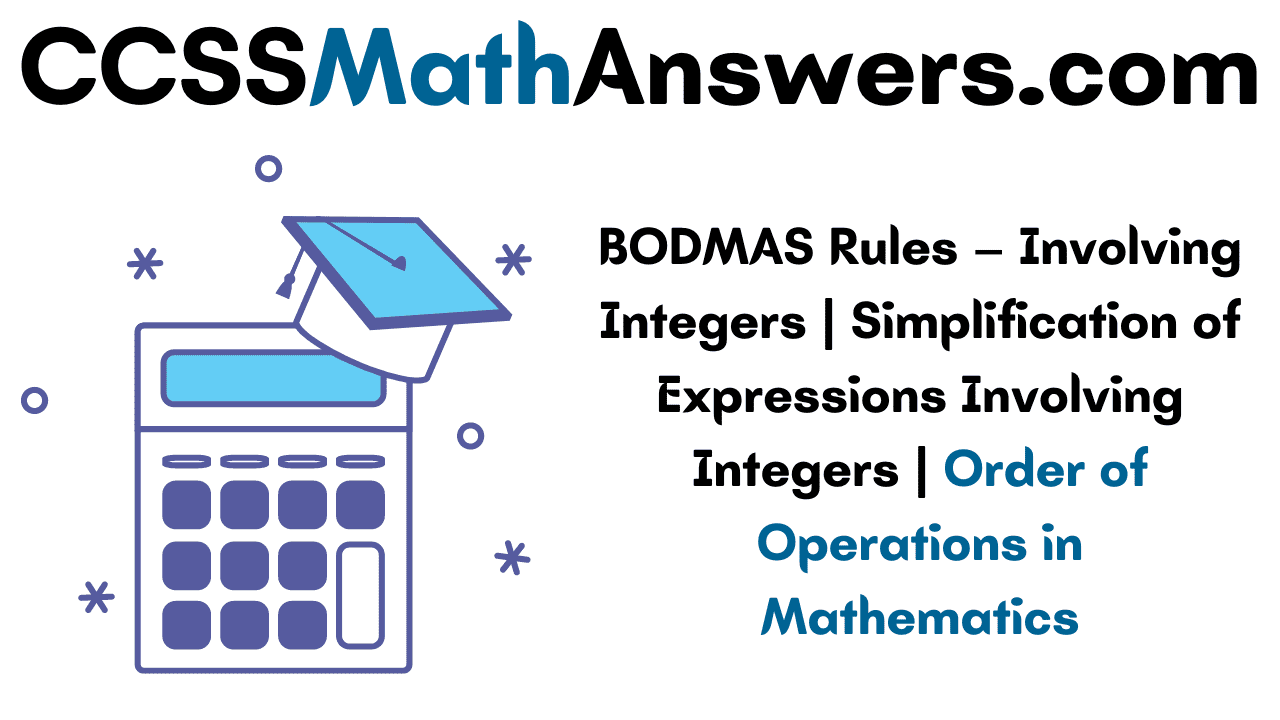For the simplification of involving integers in an arithmetic expression, we have to follow the BODMAS Rules. It is the basic order for mathematic operations. In BODMAS every letter indicates one operation and we have to place it in a specific order to simplify any arithmetic operation easily.
B stands for Bracket, O stands for order or of, D stands for Division, M stands for Multiplication, A stands for Addition and S stands for Subtraction. We have to follow the above priority levels for every arithmetic operation simplification process which involves integers.
Read More:
BODMAS Rules Involving Integers Questions
Example 1.
Solve the below expressions by using BODMAS Rule
(i) 6 × (10 + 5).
(ii) 2 + 5 of 3 – 6.
(iii) 10 ÷ 2 × 3 + 6.
(iv) 15 + (6 × 3) – 20 ÷ 5.
(i) 6 × (10 + 5).
Solution:
The given expression is 6 × (10 + 5).
As per the BODMAS rule, simplify the bracket terms first and then multiplication.
6 × (10 + 5) = 6 × 15.
= 90.
Therefore, 6 X (10 + 5)is equal to 90.
(ii) 2 + 5 of 3 – 6.
Solution: The given expression is 2 + 5 of 3 – 6.
As per the BODMAS rules, we have to simplify the ‘of’ term first and then addition and subtraction terms.
2 + 5 of 3 – 6 = 2 + 5 × 3 – 6.
= 2 + 15 – 6.
= 17 – 6.
= 11.
So, by simplifying the 2 + 5 of 3 – 6 is equal to 11.
(iii) 10 ÷ 2 × 3 + 6.
Solution: The given expression is 10 ÷ 2 × 3 + 6.
As per the BODMAS Rule, we have to simplify division terms first then multiplication and addition.
10 ÷ 2 × 3 + 6 = 5 × 3 + 6.
= 15 + 6.
= 21.
Therefore, by simplifying the 10 ÷ 2 × 3 + 6 is equal to 21.
(iv) 15 + (6 × 3) – 20 ÷ 5.
Solution: The given expression is 15 + (6 × 3) – 20 ÷ 5.
As per the BODMAS rule, we have to simplify the bracket terms first, then division, addition, and subtraction.
15 + (6 × 3) – 20 ÷ 5 = 15 + 18 – 20 ÷ 5.
= 15 + 18 – 4.
= 33 – 4.
= 29.
So, by simplifying the 15 + (6 × 3) – 20 ÷ 5, we will get the result as 29.
Example 2.
Simplify the below expressions by using the BODMAS rule.
(a) 15 – 24 ÷ 6 + 10 × 2.
(b) 39 – [10 + 6 of (20 – 2 + 10)].
(c) 25 – 8 of (15 – 10) + 2 × 5.
(d) 30 × 2 + 2 of (10 ÷ 2) – 10.
(a) 15 – 24 ÷ 6 + 10 × 2.
Solution:
The given expression is 15 – 24 ÷ 6 + 10 × 2.
Based on the BODMAS Rule.
15 – 24 ÷ 6 + 10 × 2 = 15 – 4 + 10 × 2 (Division first 24 ÷ 6 = 4).
= 15 – 4 + 20 (multiplication term 10 × 2 = 20).
= 35 – 4 (addition 15 + 20 = 35).
= 31 (subtraction 35 – 4 = 31).
Therefore, by simplifying the 15 – 24 ÷ 6 + 10 × 2, we will get the result as 31.
(b) 39 – [10 + 6 of (20 – 2 + 10)].
Solution: The given expression is 39 – [10 + 6 of (20 – 2 + 10)].
Based on the BODMAS Rule,
39 – [10 + 6 of (20 – 2 + 10)] = 39 – [10 + 6 of (30 – 2)] (addition term in brackets 10 + 20 =30).
= 39 – [10 + 6 of (28)] (subtraction 30 – 2= 28).
= 39 – [10 + 6 × 28].
= 39 – [10 + 168] (multiplication 6 x 28 = 168).
= 39 – 178 (addition 10 + 168 = 178).
= – 139 ( subtraction).
By simplifying the 39 – [10 + 6 of (20 – 2 + 10)], we will get the result as -139.
(c) 25 – 8 of (15 – 10) + 2 × 5.
Solution: The given expression is 25 – 8 of (15 – 10) + 2 × 5.
Based on the BODMAS rule,
25 – 8 of (15 – 10) + 2 × 5 = 25 – 8 of (5) + 2 × 5 (bracket term subtraction 15 – 10 = 5).
= 25 – 8 × 5 + 2 × 5.
= 25 – 40 + 10 (multiplication 8 × 5 = 40, 2 × 5 = 10).
= 35 – 40 (addition 25 + 10 = 35).
= – 5 (subtraction 35 – 40 = -5).
Therefore, 25 – 8 of (15 – 10) + 2 × 5 is equal to – 5.
(d) 30 × 2 + 2 of (10 ÷ 2) – 10.
Solution: The given expression is 30 × 2 + 2 of (10 ÷ 2) – 10.
Based on the BODMAS Rule,
30 × 2 + 2 of (10 ÷ 2) – 10 = 30 × 2 + 2 of (5) – 10 (division 10 ÷ 2 = 5).
= 30 × 2 + 2 × 5 – 10.
= 60 + 10 – 10 (multiplication 30 × 2 = 60, 2 × 5 = 10).
= 70 -10 (addition 60 + 10 = 70).
= 60 (subtraction 70 – 10 = 60).
Therefore, 30 × 2 + 2 of (10 ÷ 2) – 10 is equal to 60.
